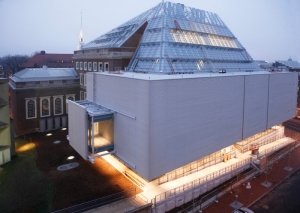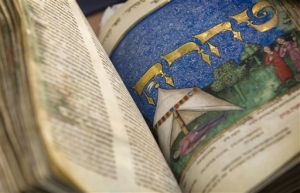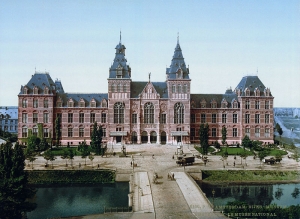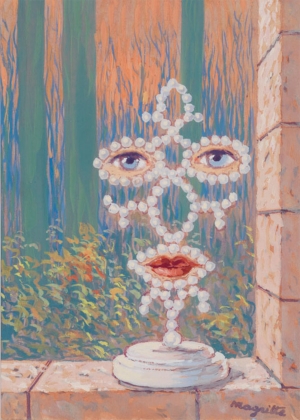|
Displaying items by tag: middle ages
Works by Kandinsky, Chagall and Malevich are due to travel from Russia to Spain for the opening of Malaga’s State Russian Museum this March. The first European branch of the St. Petersburg institution is due to be housed in a former tobacco factory in the southern Spanish city.
The inaugural display, “Russian Art of the XV-XX centuries”, traces a path of the country’s art history through 100 works, beginning with Russian icons from the end of the Middle Ages to Modernism and concluding with Soviet Realism. The director of the Russian State Museum, Vladimir Gusev, told "El Diario Sur" in an interview: “we want to break the stereotypes of Russian art.”
Bellini. Botticelli. Titian. "Of Heaven and Earth: 500 Years of Italian Painting from Glasgow Museums" celebrates the richness of Italy’s artistic legacy. It features religious paintings of the late Middle Ages and Renaissance, along with secular Neoclassical and genre paintings of the nineteenth century—with the principal artistic centers, such as Bologna, Florence, Milan, Naples, Rome, and Venice, represented. Milwaukee is the only Midwest stop on the tour of this rare exhibition.
Opening with some of the earliest and most refined examples of Italian painting, including Sandro Botticelli’s stunning "Annunciation," the exhibition unfolds chronologically.

On November 16, 2014, the Harvard Art Museums -- including the Busch-Reisinger Museum, the Arthur M. Sackler Museum, and the Fogg Museum of Art -- will reopen to the public under one state-of-the art roof. The project, which began in 2008, has entailed a complete renovation and expansion of Harvard’s museum system. The endeavor has increased gallery space by 40 percent, for a total of approximately 43,000 square feet.
Harvard tapped renowned architect Renzo Piano to transform 32 Quincy Street in Cambridge, Massachusetts, the landmark building that previously housed the Fogg and Busch-Reisinger Museum, into the university’s artistic hub. The new facility combines the 32 Quincy Street building, which was constructed in 1927, with a new addition and a striking glass rooftop structure that will allow controlled natural light into the facility’s conservation lab, study centers, and galleries. The overhaul also includes a theater for lectures and public programming.
The Busch-Reisinger Museum, which was founded in 1903, is the only museum in North America dedicated to the art of the German-speaking countries of Central and Northern Europe. The Fogg Art Museum, which opened to the public in 1896, boasts extensive holdings of American and European art from the Middle Ages to the present. The Arthur M. Sackler Museum, which holds a remarkable Asian art collection, was established in 1985 in a separate building from the Fogg and Busch-Reisinger. The museum has been closed since June to prepare for its relocation to the new facility.
Thomas W. Lentz, the Elizabeth and John Moors Cabot Director of the Harvard Art Museums, said, “We knew that we had an opportunity to redefine the Harvard Art Museums as an accessible and connected 21st-century facility for teaching and learning, so we engaged Renzo Piano to design a building to implement that vision. We asked him to design it from the inside out—to create a new kind of laboratory for the fine arts that would support our mission of teaching across disciplines, conducting research, and training museum professionals. We also wanted to strengthen the museums’ role as an integral part of Cambridge and Boston’s cultural ecosystem. We look forward to welcoming students, faculty, and staff at Harvard, our Cambridge friends and neighbors, the entire Greater Boston community, and travelers from afar into our new home this November.”

Since September 2013, the National Gallery of Art in Washington, D.C. has acquired a number of important works from the 15th through 20th centuries including tempera-and-gold drawings on vellum from the Middle Ages and works on paper by Paul Cézanne, Claude Monet and Paul Gauguin. Earl A. Powell III, the director of the National Gallery of Art, said, “These acquisitions are masterworks from the Middle Ages to the current moment that represent the highest levels of creativity in media ranging from printmaking and manuscript illumination to easel painting and photography. We are delighted that they can be shared with the public as part of our permanent collection.”
Among the museum’s recent acquisitions are a woodcut-illustrated book of Giovanni Boccaccio’s ‘Seminal History of Famous Women’, the Gallery’s earliest German woodcut book; ‘Still Life with Peacock Pie,’ a banquet piece measuring more than four feet across by the Dutch Golden Age painter Pieter Claesz; one of Jean-Honoré Fragonard’s finest versions of ‘Avenue of Cypresses at Villa d’Este’; a watercolor by Cézanne titled ‘A Stand of Trees Along a River Bank’; an early drawing by Gauguin titled ‘Seated Nude Seen from Above’; a pastel of Waterloo Bridge by Monet; and Pop artist Jim Dine’s ‘Name Painting.’ The National Gallery of Art also received works by artists such as Roy Lichtenstein, Pablo Picasso, Andy Warhol, Marc Chagall, Jasper Johns and Robert Motherwell from the celebrated Herbert and Dorothy Vogel Collection.
The National Gallery of Art was established in 1937 for the people of the United States by a joint resolution of the U.S. Congress. Financier and art collector, Andrew W. Mellon, donated a portion of his sizeable art collection to the museum, forming its core holdings. The National Gallery of Art’s collection of paintings, drawings, prints, photographs, sculptures and decorative arts spans from the Middle Ages to the present and includes the only painting by Leonardo da Vinci in the Americas as well as the largest mobile ever created by Alexander Calder.

On Monday, April 29, 2013 the Metropolitan Museum of Art in New York and the Israel Museum in Jerusalem announced that they had come together to jointly acquire the Mishneh Torah. A rare 15th century illuminated Hebrew manuscript, the Mishneh Torah features text from Moses Maimonides, a Jewish writer and philosopher from the Middle Ages. The Met and the Israel Museum have agreed to exhibit the Torah at both institutions on a rotating schedule.
Created in 1457, the Mishneh Torah is the second of a two-volume manuscript and features six large illustrations and 32 smaller images in the style of Northern Italian Renaissance miniature painting. The Vatican owns the first volume of the manuscript. The Mishneh Torah was restored at the Israel Museum’s conservation lab and has been on loan to the institution since 2007.
The Mishneh Torah was to be the leading item at an auction of the collection of Michael and Judy Steinhardt on Monday at Sotheby’s. The manuscript, which was expected to bring between $4.5 million and $6 million at auction, was purchased by the museums before the sale began. Sotheby’s has declined to reveal how much the two institutions paid for the Mishneh Torah.
Michael Steinhardt, a hedge fund manager and philanthropist, and his wife, Judy, have amassed a renowned Judaica collection, which includes silver and decorative objects, textiles, and fine art. Steinhardt said, “The acquisition of this remarkable manuscript by the Israel Museum and the Metropolitan Museum of Art is poetic given Judy’s and my longstanding involvement with both institutions; it is particularly meaningful that this event marks the first significant collaboration between the two museums.”

Officials at the Rijksmuseum in Amsterdam announced that the museum will reopen to the public on April 14, 2013. The Rijksmuseum, a Dutch national institution devoted to arts, crafts, and history, has been closed for 10 years as part of a massive renovation and modernization project.
The museum is currently working to reinstall around 8,000 masterpieces from the national collection spanning from the Middle Ages to present day. While the Rijksmuseum’s main building was closed, the institution sent a selection of 400 works, including their most famous painting, Rembrandt’s (1606-1669) The Night Watch (1642), to the Philips Wing, a previously renovated “fragment building” belonging to the museum. The works formed a major exhibition titled Masterpieces of the Dutch Golden Age, which saw approximately 1 million visitors during its run.
The Rijksmuseum renovation cost approximately $481 million to complete and included restoring all eighty of the museum’s galleries with their original decorations and paintings as well as implementing the most up-to-date technologies and applications. The project was expected to reach completion in 2008, but a series of contractor issues and planning problems delayed progress.
Museum officials expect attendance to increase significantly after the institution reopens; prior to the Rijksmuseum’s closure, it saw approximately 1 million visitors each year. The museum is also planning to stay open 365 days a year, which would make it the first national museum in the world to be open every day.

Officials at Harvard University in Cambridge, MA announced that they will open the newly renovated and expanded Harvard Art Museums in the fall of 2014. The project, which began in 2008, has entailed a complete reinvention of Harvard’s museum system and will place the Busch-Reisinger Museum, the Arthur M. Sackler Museum, and the Fogg Museum of Art under one state-of-the-art roof.
Renowned architect Renzo Piano was enlisted to transform 32 Quincy Street, the landmark building that currently houses the Fogg and Busch-Reisinger museums, into Harvard’s artistic hub. The new facility will combine the 32 Quincy Street building, which was constructed in 1927, with a new addition and a striking glass rooftop structure that will allow controlled natural light into the facility’s conservation lab, study centers, and galleries. The overhaul also includes a theater for lectures and public programming.
The Arthur M. Sackler Museum, which was established in 1985 in a separate building from the Fogg and Busch-Reisinger, has remained open during the recent construction. The Sackler will close June 1, 2013 to prepare for the relocation of its remarkable Asian art collection to 32 Quincy Street.
The Bush-Reisinger Museum, which was founded in 1903, is the only museum in North America dedicated to the art from the German-speaking countries of Central and Northern Europe. The Fogg Art Museum, which opened to the public in 1896, boasts extensive holdings of American and European art from the Middle Ages to the present.

Now in its 58th year, the Brussels Antiques and Fine Art Fair (BRAFA) will take place January 19-27, 2013 at the exhibition space, Tour & Taxis. Featuring 128 dealers from 11 countries, the fair will present works from the Middle Ages to the 20th century including antiquities, jewelry, furniture, ceramics, drawings, engravings, Old Master as well as modern paintings, sculpture, textiles, contemporary art, photography, and much more.
After drawing in 46,000 visitors last year, BRAFA organizers have made a number of adjustments in hopes of surpassing 2012’s numbers. There will be 26 new exhibitors present and an increased emphasis has been placed on pre-Columbian art; archaeology; primitive arts; 17th to 19th century furniture; 19th to 20th century paintings, sculptures, and drawings; Asiatic arts; 20th century decorative arts; and modern and contemporary art. BRAFA has also added a new section to this year’s fair devoted to manuscripts. Exhibitors in this section include Signatures (Paris), Librairie Thomas-Scheler (Paris), and Sanderus Antiquariaat (Ghent, Belgium).
In honor of the fair’s tenth year at Tour & Taxis, BRAFA’s architects, Volume Architecture, have designed an extraordinary entrance inspired by Byzantine architecture, particularly that of the mosques in Istanbul.
VIP guests will be given a sneak peek of the impressive fair at BRAFA’s exclusive charity event on January 18. A silent auction will be held during the evening and proceeds will benefit the Merode Foundation to support its work on educational and social projects in Brussels’ working class neighborhoods.
Exhibitor highlights include Whitford Fine Art (London), which specializes in French and British 20th century painting and sculpture, Leysen Jewelers (Belgium), jewelers to the Belgian royal family, and Guy Pieters Gallery (Paris/Belgium), a leading force in the contemporary art world for the past 30 years.

Held from November 7th to 12th at the Palais de la Bourse, Paris Tableau will try to outdo last year’s inaugural show, which saw over 6,000 patrons and sold 60 major paintings.
Centered on Old Master Paintings ranging from the Middle Ages to the Second Empire, Paris Tableau was created by ten dealers – Maurizio Canesso, Hervé Aaron, Eric Coatalem, Bertrand Gautier, Bob Haboldt, Jean-François Heim, Georges de Jonckheere, Jacques Leegenhoek, Giovanni Sarti and Claude Vittet – who all share the same vision. While multi-discipline art fairs are currently commonplace, the dealers felt a fair dedicated solely to Old Masters was both needed and desired by collectors, curators, and fans.
This year’s Paris Tableau will host a loan exhibition from Le Mobilier National (The National Furniture Museum of France). Curated by Arnauld Brejon de Lavergnée, the former Director of Collections at Le Mobilier National, Hidden Treasures of the Goblins, will feature approximately 20 paintings and painted cartoons, some of which have never before been on public display. The point of the exhibition is to illustrate the link between paintings and its translation into textiles for interior use.
A festival of iconic films that thematically explore Old Master Paintings will also be part of Paris Tableau. Held from November 9th to 10th, the festival features such films as Rembrandt, Nightwatching, The Mill and the Cross, and The Girl with a Pearl Earring.
|
|
|
|
|